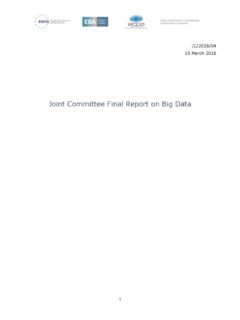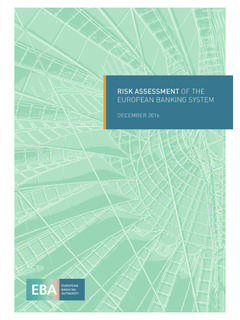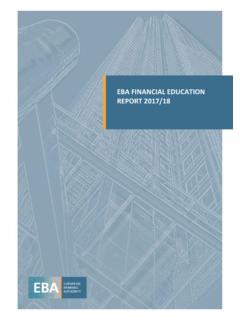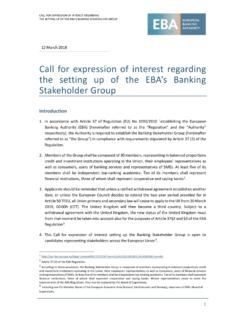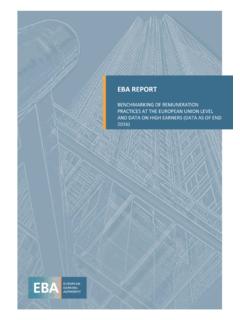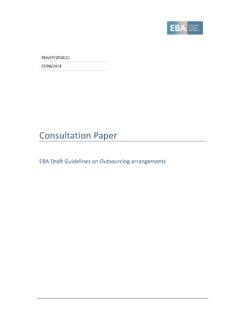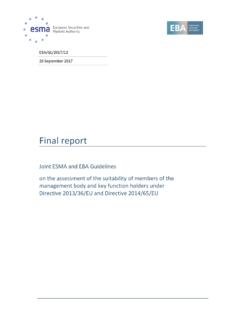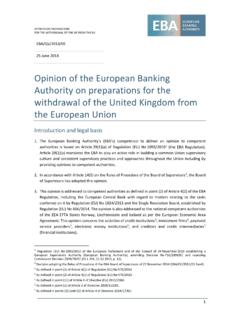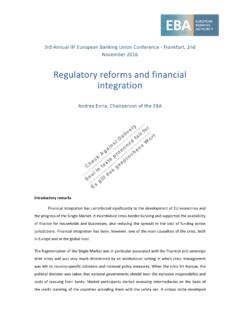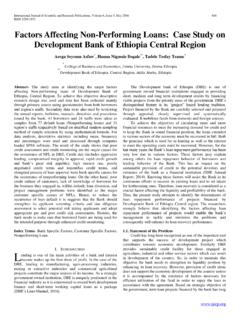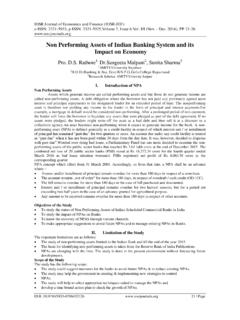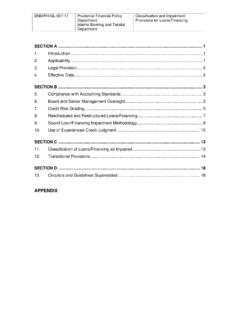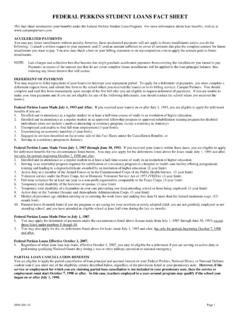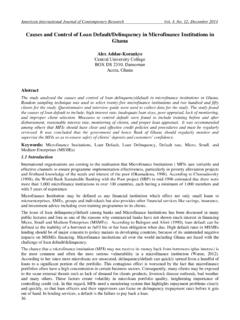Transcription of BoS 2018 xx CP on Draft GL on disclosure of non-performing ...
1 EBA/CP/2018/06 27 April 2018 Consultation Paper Draft Guidelines on disclosure of non-performing and forborne exposures CONSULTATION PAPER ON Draft GUIDELINES ON disclosure OF non-performing AND FORBORNE EXPOSURES 2 Contents to this consultation3 Summary4 and rationale5 Guidelines on disclosure of non-performing and forborne exposures9 Compliance and reporting obligations11 Subject matter, scope and definitions12 Implementation15 Annex I disclosure templates: Forbearance16 Annex II disclosure templates: non-performing exposures21 Annex III disclosure templates: Collateral valuation33 Annex IV disclosure templates: Changes in the stock of NPLs37 Annex V disclosure templates: Foreclosed assets40 documents45 Draft cost-benefit analysis / impact assessment45 Overview of questions for consultation53 Feedback on the public consultation and on the opinion of the BSG54 CONSULTATION PAPER ON Draft GUIDELINES ON disclosure OF non-performing AND FORBORNE EXPOSURES 3 to this consultationThe EBA invites comments on all proposals put forward in this paper and in particular on the specific questions summarised in Comments are most helpful if they: respond to the question stated; indicate the specific point to which a comment relates; contain a clear rationale; provide evidence to support the views expressed/ rationale proposed; and describe any alternative regulatory choices the EBA should consider.
2 Submission of responses To submit your comments, click on the send your comments button on the consultation page by Please note that comments submitted after this deadline, or submitted via other means may not be processed. Publication of responses Please clearly indicate in the consultation form if you wish your comments to be disclosed or to be treated as confidential. A confidential response may be requested from us i n accordance with the EBA s rules on public access to documents. We may consult you if we receive such a request. Any decision we make not to disclose the response is reviewable by the EBA s Board of Appeal and the European Ombudsman. Data protection The protection of individuals with regard to the processing of personal data by the EBA is based on Regulation (EC) N 45/2001 of the European Parliament and of t he Council of 18 December 2000 as implemented by the EBA in its implementing rules adopted by i ts Management Board. Further information on data protection can be found under the Legal notice section of the EBA website.
3 CONSULTATION PAPER ON Draft GUIDELINES ON disclosure OF non-performing AND FORBORNE EXPOSURES 4 2. Executive financial crises negatively affected the European banking sector and contributed to a build-up of non-performing exposures (NPE) in many banks' balance sheets. The overall level of NPEsremains high by historic standards, especially in some jurisdictions, even if the joint efforts ofbanks, supervisors, regulators and macro prudential authorities led to the slow improvement ofNPE ratios in recent July 2017, the European Union Council agreed on an Action Plan1 to tackle non-performingloans (NPLs) in Europe. The Council s Conclusions stressed that a comprehensive approachcombining a mix of complementing policy actions, at national and European level, is needed toaddress the existing stock of non-performing loans (NPLs) as well as to prevent the emergenceand accumulation of new NPEs on banks balance sheets. In this regards, the EBA, along withother bodies and institutions, was invited by the Council to contribute to this Action Plan with anumber of initiatives.
4 The enhanced disclosure requirements developed in these guidelines areone of the initiatives that the EBA is guidelines specify a common content and uniform disclosure formats on information onNPEs, forborne exposures and foreclosed assets that credit institutions should is embedded in the guidelines based on two criteria, the significance of the credit institution and the level of NPEs, and there is a set of templates that only need to be disclosedby significant credit institutions with a high level of NPEs. The aim of the guidelines is theprovision of meaningful information to market participants on credit institutions asset quality,and a better insight on the distribution and level of collateralization of NPEs for those with highlevel of NPEs, better conveying the credit institutions risk profile, in line with Article 2 of Regulation (EU) No 575/2013 (CRR). Eventually, the guidelines seek to reduceinformation asymmetry and promote comparability of credit institutions risk profile and, in theend, market steps EBA aims to issue the Draft guidelines for consultation during the summer of 2018 and topublish the final guidelines, taking into account the comments received during the consultation,before the end of # CONSULTATION PAPER ON Draft GUIDELINES ON disclosure OF non-performing AND FORBORNE EXPOSURES 5 3.
5 Background and rationale 5. The financial crises negatively contributed to the build-up of large stock of non-performing exposures (NPE) in bank balance sheets. The stock of non-performing loans (NPLs) in the EU banking sector amounted to EUR 990 Billion at the end of 2016, and EUR 810 Billion in Q4 2017, equaling and of total loan portfolios respectively. The EU average NPE ratio was in Q4 6. While the dispersion of the stock of NPEs is uneven across Member States, the problem is undeniably European considering its scale and cross border implications with 12 Member States experiencing above average NPE ratios. The overall level remains high by historic standards and the improvement of NPE ratios has been disappointingly slow, even if the joint efforts of banks, supervisors and macro prudential authorities recently led to an acceleration of the adjustment. 7. The EBA s risk analysis, supported by similar research conducted by other international organisations, pointed out that high levels of NPEs are a drag on profitability and are strongly correlated with weak lending growth.
6 In addition, the effects of high levels of NPEs in bank balance sheets on funding costs and capital and efficiency among other, can seriously jeopardise institutions ability to run a viable and sustainable business model. 8. NPEs are a problem at multiple levels: at micro prudential level, heightened NPEs are associated with lower profitability and lower efficiency; at macro prudential level, high levels of NPEs are connected to stagnant growth as capital is tied up with NPEs and decreased new lending into the real economy. In addition, a high stock of NPEs negatively affect the resilience of the banking sector to shocks and hence increases systemic risk. All of these effects must be tackled in a comprehensive manner. 9. In 2014, the EBA published an ITS on supervisory reporting introducing definitions of NPE and forborne exposures (FBE) to facilitate identification of problematic assets. 10. In July 2017 the European Union Council agreed on an Action Plan3 to tackle NPLs in Europe.
7 The Council s Conclusions stressed that a comprehensive approach combining a mix of complementing policy actions, at national and at the European level where appropriate, is the most effective way to address the existing stock of NPEs as well as the emergence and accumulation of new NPEs on banks balance sheets. The policy actions should cover the following four policy areas: (i) supervision, (ii) structural reforms of insolvency and debt recovery frameworks, (iii) development of secondary markets for distressed assets, and (iv) restructuring of the banking system. In this regard, the EBA, along with other bodies and institutions, was invited by the Council to contribute to this Action Plan with a number of initiatives and action points, in particular on (i) and (iii). There are two specific initiatives in which the EBA is involved and that require disclosure related actions: 2 The EBA Risk Dashboard data as of Q3 2017 3 # CONSULTATION PAPER ON Draft GUIDELINES ON disclosure OF non-performing AND FORBORNE EXPOSURES 6 (i) The Council invites the EBA to issue guidelines on NPL management consistent with the ECB-SSM "Guidance to banks on non-performing Loans" (SSM Guidance).
8 The SSM Guidance follows the life cycle of NPL management: It starts with the supervisory expectations on NPL strategies, which closely link to NPL governance and operations. Following this, the guidance outlines important aspects for forbearance treatments, and NPL recognition, including disclosure of NPLs. Then qualitative guidance on NPL provisioning and write-off is provided and eventually collateral valuation is also addressed. (ii) In addition, the Council invites the EBA, in consultation with the ESMA and competent authorities, to implement by the end of 2018 enhanced disclosure requirements on asset quality and non-performing loans to all banks. 11. The EBA has therefore undertaken various actions which can be categorised into (i) enhancement of disclosure requirements, (ii) supervisory guidance, and (iii) improving efficiency of secondary markets. (iii) These guidelines include enhanced disclosure requirements on NPEs, forbearance and foreclosed assets applicable to all banks.
9 It also includes more specific disclosure requirements applicable to significant credit institutions that report high levels of non-performing loans. When issuing these guidelines, the EBA is implementing enhanced disclosure requirements that are consistent with the disclosure part of the NPL management cycle described in the SSM Guidance, following the Council requests on disclosure related topics. The EBA is also developing new supervisory reporting requirements on NPEs, and there will be alignment between the disclosure templates included in these guidelines and the supervisory reporting data. (iv) The EBA is also developing guidelines on management of non-performing and forborne exposures that provide supervisory guidance, and set rules for suitable NPE management that should be applied by credit institutions to facilitate the effective management of the stock and flow of NPEs. The aim is to achieve sustainable reduction of NPEs in credit institutions balance sheets.
10 (v) Additionally, and in order to enhance supervisory guidance, the EBA will issue guidelines on banks loan origination monitoring and internal governance. (vi) On the secondary market development, in December 2017 the EBA published uniform and standardised templates to facilitate the screening and financial due diligence phase of NPLs transactions. In particular the EBA NPL transaction templates will serve for the financial due diligence and valuation of portfolios and the EBA NPL portfolio screening templates will be particularly useful for the initial screening of portfolios. CONSULTATION PAPER ON Draft GUIDELINES ON disclosure OF non-performing AND FORBORNE EXPOSURES 7 Objective and structure of the guidelines 12. Proportionality is embedded in the guidelines based on the significance of the credit institutions and their level of NPEs; there is a set of templates applicable to all credit institutions and some additional templates applicable only to significant credit institutions with a high level of NPEs.
